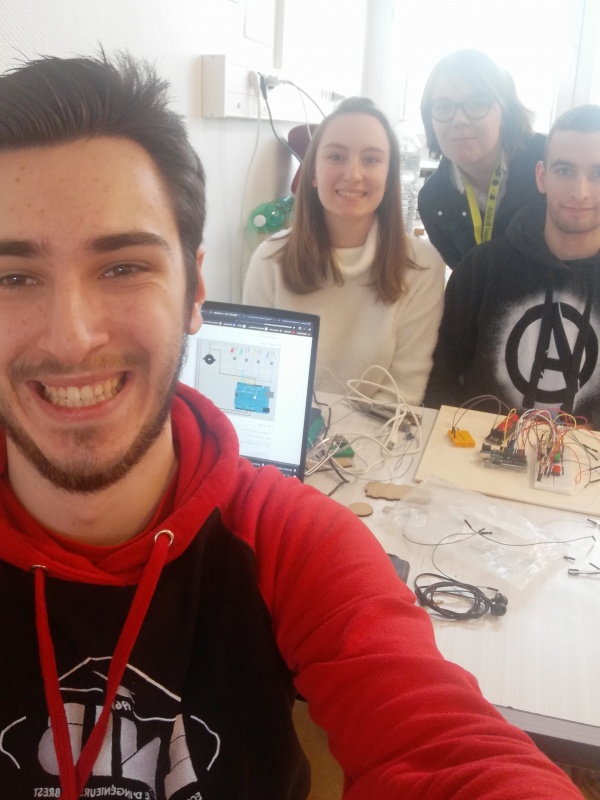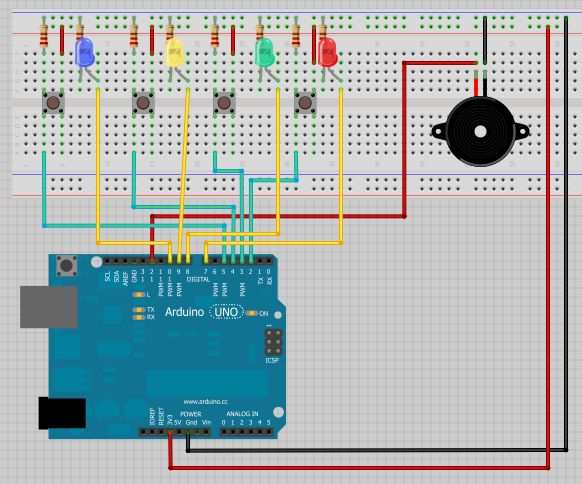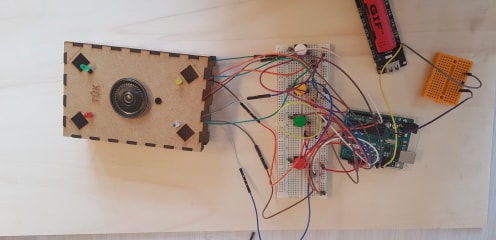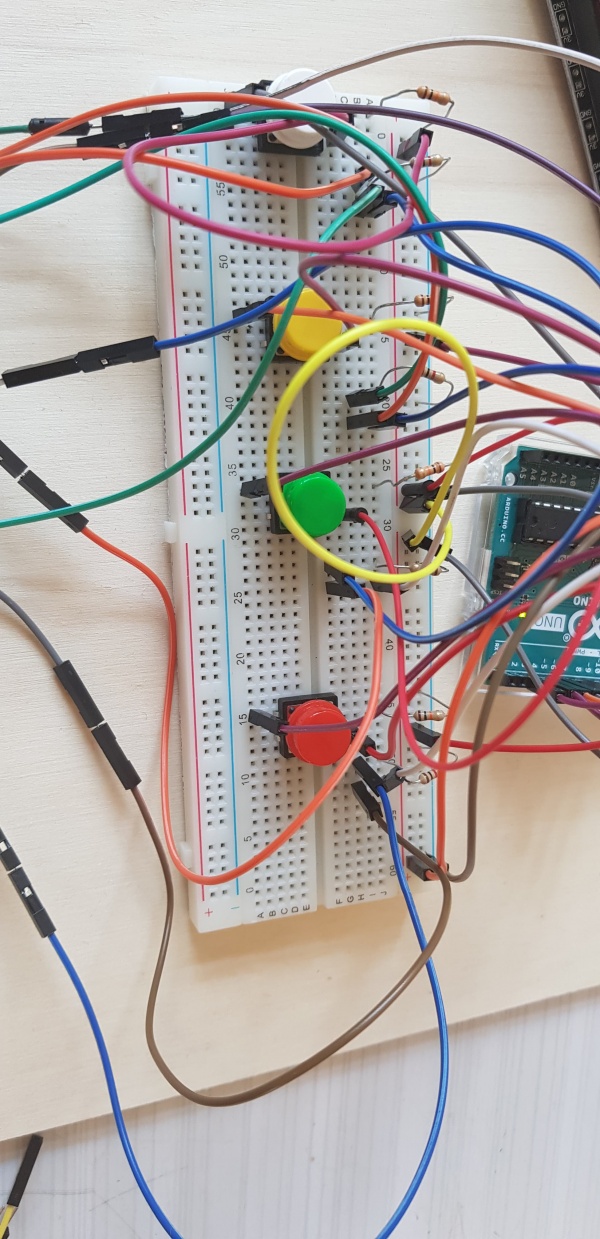ENIB 2020 : Tûk
Sommaire
photo de l'équipe
Que fait ce projet ?
Tûk est un jeu de mémoire très inspiré du jeu Simon. Le principe du jeu se résume à suivre une séquence de couleurs données par le jeu. Par exemple, si la première couleur qui s'allume est le jaune. Le joueur doit donc appuyer sur le bouton jaune. Puis Tûk rajoute des couleurs au fur et à mesure que le joueur réussi à répéter les séquences. La séquence est réinitialisée à une couleur et la partie redémarre.
Liste des composants
- 1 carte Arduino
- 4 boutons poussoirs de couleur différentes
- 4 LED de même couleur que les boutons
- 1 haut-parleur
- des câbles
- une boîte faite maison (medium 3mm)
- 1 pain de câblage
- 1 support batterie
- 1 pile rechargeable
- 4 résistances de 1kΩ
- 4 résistances de 10kΩ
Montage
Code
/*Created by Jeremy Wilson
Memory Game with Arduino
Modified by Rui Santos
Visit: http://randomnerdtutorials.com
*/
// Constants
const int button1 = 2; // 1st button controls Blue LED
const int button2 = 3; // 2nd button controls Yellow LED
const int button3 = 4; // 3rd button controls Green LED
const int button4 = 5; // 4th button controls Red LED
const int led1 = 7; // Blue LED
const int led2 = 8; // Yellow LED
const int led3 = 9; // Green LED
const int led4 = 10; // Red LED
const int buzzer = 12; // Buzzer Output
const int tones[] = {1915, 1700, 1519, 1432, 2700}; // tones when you press the LED's - the last one is when you fail.
// Variables
int buttonState[] = {0,0,0,0}; // current state of the button
int lastButtonState[] = {0,0,0,0}; // previous state of the button
int buttonPushCounter[] = {0,0,0,0};
void playTone(int tone, int duration) {
for (long i = 0; i < duration * 1000L; i += tone * 2) {
digitalWrite(buzzer, HIGH);
delayMicroseconds(tone);
digitalWrite(buzzer, LOW);
delayMicroseconds(tone);
}
}
void setup() {
// initialize inputs :
randomSeed(analogRead(0));
pinMode(button1, INPUT);
pinMode(button2, INPUT);
pinMode(button3, INPUT);
pinMode(button4, INPUT);
// initialize outputs:
pinMode(led1, OUTPUT);
pinMode(led2, OUTPUT);
pinMode(led3, OUTPUT);
pinMode(led4, OUTPUT);
pinMode(buzzer, OUTPUT);
// initialize serial communication for debugging:
//Serial.begin(9600);
}
int game_on = 0;
int wait = 0;
int currentlevel = 1; // This is the level (also the number of button presses to pass to next level)
long rand_num = 0; //initialize long variable for random number from 0-100.
int rando = 0; //initialize random integer for loopgame_on. Will be from 1-4 later.
int butwait = 500; //amount of time to wait for next button input (ghetto de-bounce)
int ledtime = 500; //amount of time each LED flashes for when button is pressed
int n_levels = 10; //number of levels until the game is won
int pinandtone = 0; //This integer is used when the sequence is displayed
int right = 0; //This variable must be 1 in order to go to the next level
int speedfactor = 5; //This is the final speed of the lights and sounds for the last level. This increases as more games are won
int leddelay = 200; //Initializing time for LED. This will decrease as the level increases
void loop() {
int n_array[n_levels];
int u_array[n_levels];
int i;
//clears arrays both "n_array" and "u_array" and starts a new game
if (game_on == 0){
for(i=0; i<n_levels; i=i+1){
n_array[i]=0;
u_array[i]=0;
rand_num = random(1,200);
if (rand_num <= 50)
rando=0;
else if (rand_num>50 && rand_num<=100)
rando=1;
else if (rand_num>100 && rand_num<=150)
rando=2;
else if (rand_num<=200)
rando=3;
//saves a random number in our n_array
n_array[i]=rando;
}
game_on = 1;
}
//shows the user the current sequence
if (wait == 0){
delay (200);
i = 0;
for (i = 0; i < currentlevel; i= i + 1){
leddelay = ledtime/(1+(speedfactor/n_levels)*(currentlevel - 1));
pinandtone = n_array[i];
digitalWrite(pinandtone+7, HIGH);
playTone(tones[pinandtone], leddelay);
digitalWrite(pinandtone+7, LOW);
delay(100/speedfactor);
}
wait = 1;
}
i = 0;
int buttonchange = 0;
int j = 0; // This is the current position in the sequence
while (j < currentlevel){
while (buttonchange == 0){
for (i = 0; i < 4; i = i + 1){
buttonState[i] = digitalRead(i+2);
buttonchange = buttonchange + buttonState[i];
}
}
for (i = 0; i < 4; i = i + 1){
if (buttonState[i] == HIGH) {
digitalWrite(i+7, HIGH);
playTone(tones[i], ledtime);
digitalWrite(i+7, LOW);
wait = 0;
u_array[j]=i;
buttonState[i] = LOW;
buttonchange = 0;
}
}
if (u_array[j] == n_array[j]){
j++;
right = 1;
}
else{
right = 0;
i = 4;
j = currentlevel;
wait = 0;
}
}
if (right == 0){
delay(300);
i = 0;
game_on = 0;
currentlevel = 1;
for (i = 0; i < 4; i = i + 1){
digitalWrite(i+7, HIGH);
}
playTone(tones[4], ledtime);
for (i = 0; i < 4; i = i + 1){
digitalWrite(i+7, LOW);
}
delay (200);
for (i = 0; i < 4; i = i + 1){
digitalWrite(i+7, HIGH);
}
playTone(tones[4], ledtime);
for (i = 0; i < 4; i = i + 1){
digitalWrite(i+7, LOW);
}
delay(500);
game_on = 0;
}
//if you insert the right sequence it levels up
if (right == 1){
currentlevel++;
wait = 0;
}
//if you finish the game
if (currentlevel == n_levels){
delay(500);
// The following is the victory sound:
int notes[] = {2, 2, 2, 2, 0, 1, 2, 1, 2};
int note = 0;
int tempo[] = {200, 200, 200, 400, 400, 400, 200, 200, 600};
int breaks[] = {100, 100, 100, 200, 200, 200, 300, 100, 200};
for (i = 0; i < 9; i = i + 1){
note = notes[i];
digitalWrite(note+7, HIGH);
playTone(tones[note], tempo[i]);
digitalWrite(note+7, LOW);
delay(breaks[i]);
}
//sets game_on to 0, so it restarts a new game
game_on = 0;
currentlevel = 1;
n_levels = n_levels + 2;
speedfactor = speedfactor + 1;
}
}




